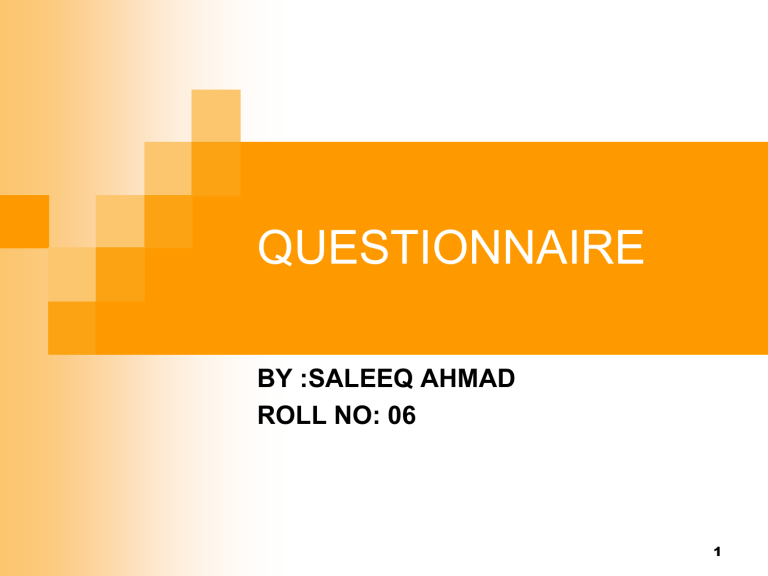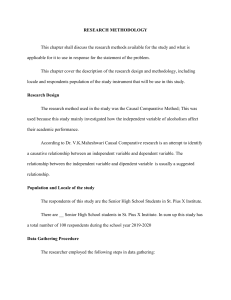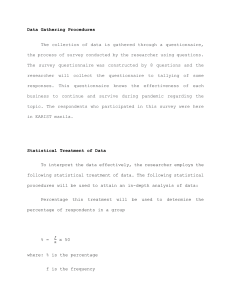
QUESTIONNAIRE BY :SALEEQ AHMAD ROLL NO: 06 1 Definition of a Questionnaire A set of questions on a topic or group of topics designed to be answered by the respondent. It is the vehicle used to pose the questions that the researcher wants respondents to answer 2 Advantages of the Questionnaire 1. Requires less skill. 2. Less training is needed. 3. Cheaper in nature. 4. Also impersonal in nature. 5. Pressure is less. 6. Anonymity. 7. Suitable for geographically scattered population 3 Disadvantages of the Questionnaire 1. No control over respondent’s environment. 2. Response is also less. 3. No help on doubts. 4. Occurrence of errors. 5. Less reliable. 6. Sometimes answers obtained can be wrong. 7. Not suitable for illiterates. 4 TYPOLOGY OF QUESTIONIRES Open ended Simple dichotomy Question type Closed ended Multiple choice Determinant choice Check-list 5 Open ended or unstructured Questionnaire In which the respondent answers in his own words. E.g. What according to you is the biggest challenge of Academic libraries? ……………………………………………………………………………………….. Closed ended or structured Questionnaire Question in which respondent selects one or more options from pre-determined set of responses. Simple dichotomy Closed ended question with only two response alternatives. E.g. How do you rate the services of your library? Good …. Bad…… Multiple Choice Closed ended question with more than two response alternatives. E.g. How much satisfaction do you get from your job? (a) A great deal (b) Quite a bit (c) A little (d) not at all 6 Determinant choice – Multiple choice question in which respondent must select only one of the response alternatives. E.g. How much satisfaction do you get from your library job? a) A great deal b) Very little c) Fairly well d) Not at all Checklist question - Multiple choice question in which respondent can select more than one of the response alternatives E.g. Please indicate the purpose of visit in the library? ( you may tick (√) as many responses as are applicable). a) To consult text books b) To read comic Books c) To consult Journals d) To Access Internet e) To read news papers f) To listen music 7 Open Ended Questions Advantages: Freedom and spontaneity of the answers Opportunity to probe Useful for testing hypothesis about ideas Disadvantages: Time-consuming Coding: very costly and slow to process Demand more effort from the respondents 8 Closed Ended Questions Advantages: No extended writing Easy to process Useful for testing specific hypothesis Disadvantages: Loss of spontaneous response Bias in answer categories May irritate respondents 9 Question Format General Format -In possible answers general format, all possible answers are listed and respondents are required to check the appropriate categories. The respondents can tick mark, color the box or circle the number. Cafeteria Style Questions- This is another general format common style, wherein the respondent is requested to check or indicate one item that describes his situation or as many items as applicable to his situation. Likert-Type Response Format- One of the most used format where, a respondent is asked to make a judgment in terms of an ordered set of categories. 10 Other formats Bogardus: Social distance scale (1930s) Osgood: Semantic differential scale(1970s) Dorian: Ranking schemes (1981) 11 Types of Question Factual Questions Opinion and Attitude Questions Information Questions Self perception Questions Projective Questions Directional Questions Intensity Questions 12 QUESTIONNAIRE LAYOUT Ensure that questions are without bias. Make the questions as simple as possible. Make the questions very specific. Avoid jargon or shorthand. Steer clear of sophisticated or uncommon words. Avoid ambiguous words. Avoid questions with a negative in them. Avoid hypothetical questions. Do not use words which could be misheard. 13 Avoid double Negatives. Avoid using Acronyms and Abbreviations. Add note of thanks at the end. Avoid double bared questions. Avoid threatening questions. 14 Questionnaire Terms Attitude Questions:-Questions that ask respondents about their likes/dislikes, preferences, evaluation of objects, persons, organisations, events or situations Behaviour Questions:-Essentially factual and relate to what respondents did in the past, are currently doing or may do in the future Classifications Questions :- Usually factual and relate to demographic characteristics Pre-coding:-Numbering all response categories on a questionnaire so all responses receive a number as they are given Routing:-Guiding the respondent or interviewer in a questionnaire to the next relevant question depending on the answer given 15 Questionnaire Pretesting (Pilot study) Seeks to determine whether respondents have any difficulty understanding the questionnaire and whether there are any ambiguous or biased questions. By pre-testing the questionnaire, errors can be rectified and unwanted questions can be deleted, unclear language and wording can be corrected and improved. 16 Characteristics of a Good Questionnaire Covering Letter Attractive appearance, layout and size Anonymity of Respondent Objective based. Appropriate Wording Logical sequencing Brevity Practicability Validity and Reliability 17 Logical Flow Introduction Simple related questions Main body Classification details Thank and close 18 “It is not every question that deserves an answer.” Publius Syrus (Roman, 1st century B.C.) THANKS 19


